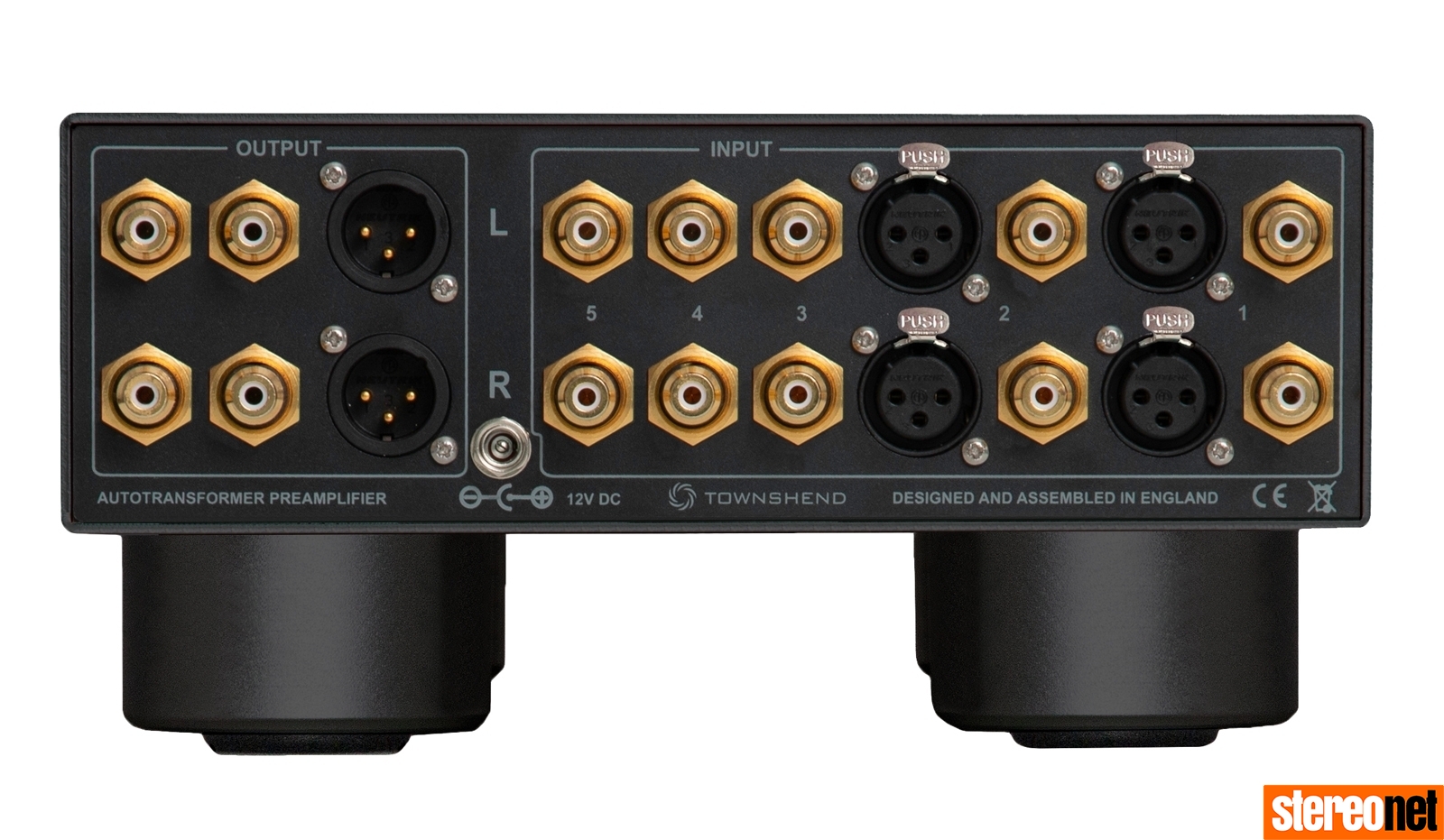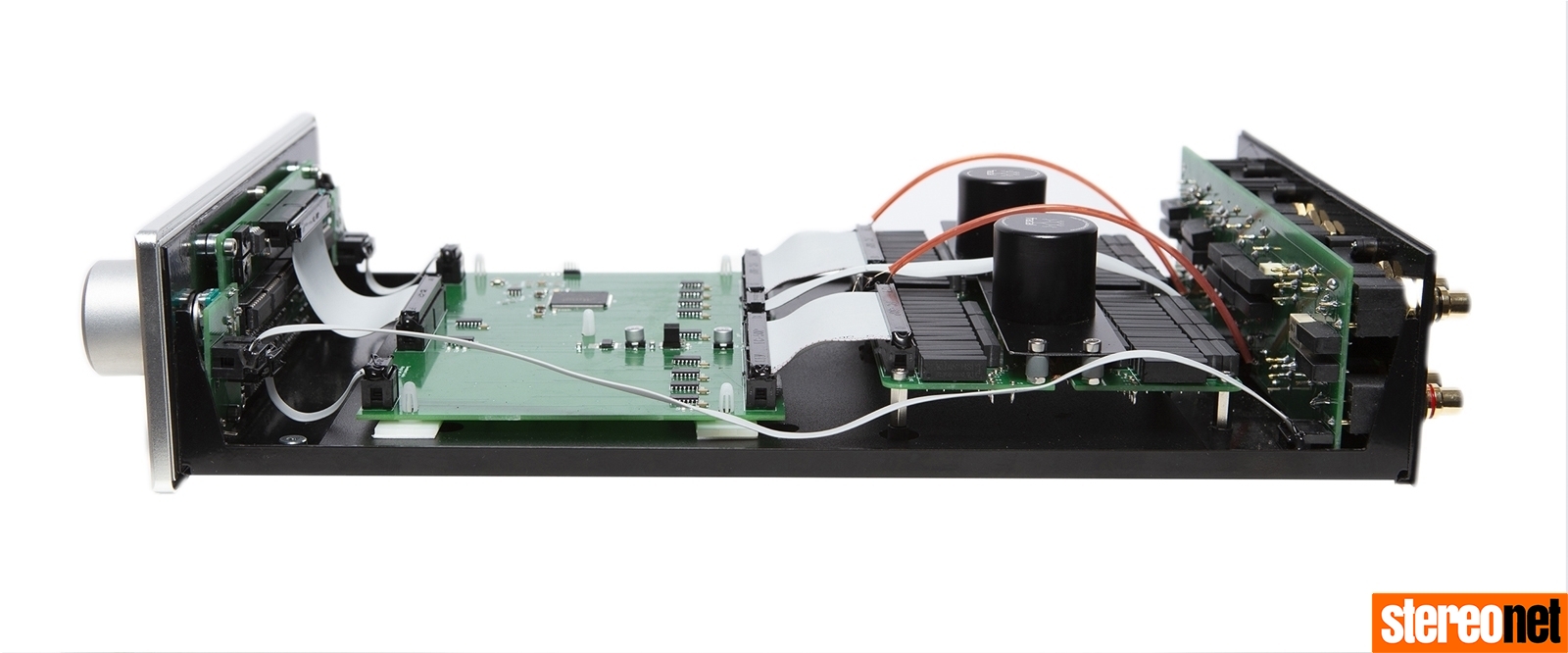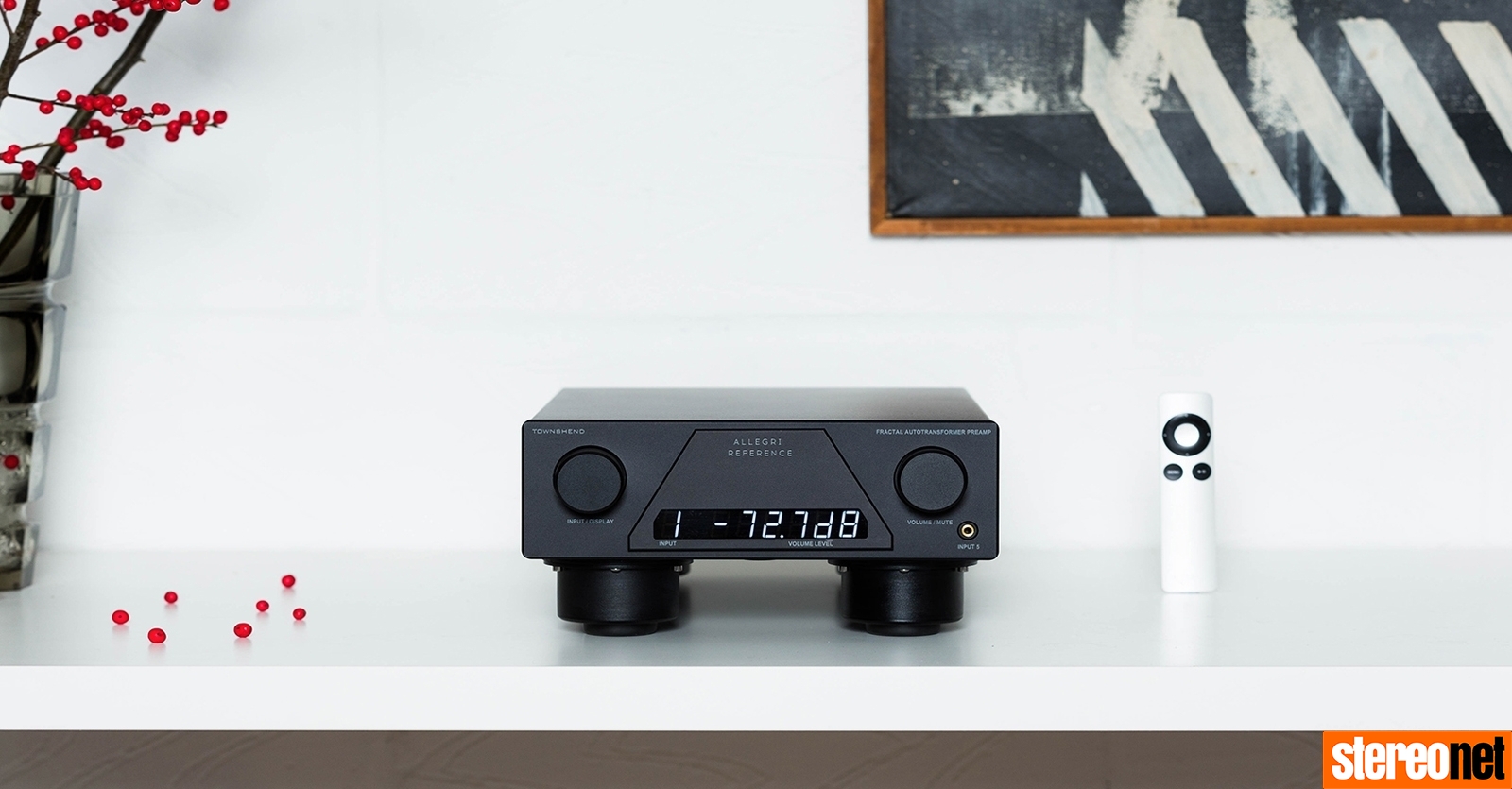Townshend Audio Allegri Reference Preamplifier Review

Rafael Todes auditions what he thinks to be one of the best high-end preamplifiers in the world…
Townshend Audio
Allegri Reference Passive Preamplifier
£7,995 RRP

The role of a hi-fi preamplifier is an interesting one. At its most basic, it’s both a volume control and a switch – but the difficult part is by far the former. Many now choose to do the volume controlling in the digital domain, but this can involve truncating bits which on a transparent system you may hear, even if a seriously good noise-shaping algorithm is used.
Another solution is to have a drawerful of active analogue electronics with an old fashioned potentiometer volume control. Most manufacturers still go this way, but the downside is that the signal goes round the houses, so to speak, rather than travelling direct. In other words, the preamp ends up being quite invasive – in turn lowering the sound quality of the original signal.
Then there’s a passive preamp, which is in effect a potentiometer in a box. It uses variable resistance to deliver the right volume level. You can liken this to driving your car flat out and then using the brakes to set your speed. It’s inexpensive but sub-optimal. Then there’s the transformer preamplifier which you might say has the effect of a far more sophisticated passive pre, using a transformer’s windings and taps to control output to the power amplifier.
Townshend’s new Allegri Reference is just this – and the latest transformer preamp from Max Townshend of Townshend Audio. He’s something of a legend in his own lifetime now, having been directly or indirectly responsible for many innovations over the years. He first cut his audio teeth on parabolic styli back in the late nineteen seventies and then designed the Rock turntable where the tip of the arm floats in a trough of silicone damping fluid to absorb vibrations. More recently, he was the first manufacturer to use cryogenically treated wire and has championed the benefits of seismic isolation which is another highly effective way of improving the sound of a system.
After a good few years selling the more affordable Allegri transformer preamp, Max has finally created the £7,995 Allegri Reference. It’s a far more elaborate affair than the cooking Allegri as you’d expect, and comes in a choice of two finishes, silver metallic or black. A frontal display shows two sets of numbers – input and volume level. For convenience’s sake – both Townshend Audio’s and the customer’s – an Apple TV remote is bundled. This is a beautifully designed product that fits in the hand better than any commercial remote I have used, and provides a wide-angle with which to control the preamp. The knobs on the preamp enable manual control of all the features found on the remote control.

At the rear of the Allegri, there are five pairs of RCA inputs and two balanced XLR inputs. The fifth input can also be accessed from the front panel with a 3.5mm stereo jack. There is also a power socket; despite this being a passive preamp, power is needed to operate the screen and the remote controller, of course. The power supply unit is a linear one, and designed to limit noise thrown into what is a very low noise environment – Max is very well aware of the sonic damage of not doing otherwise.
This rather elegant unit sits on four isolation feet, from Townshend’s own Seismic range. Inside, the transformers have 50% nickel-iron lamination core assemblies, and are wound with Townshend’s secretive ‘Fractal Cable’. This is a process Townshend has developed in the vein of cryogenically treated wire. Max is understandably reticent to discuss what this process is, given that the world and its mother now use cryogenics. Tap switching is achieved by aerospace-grade hermetically-sealed reed relays, which are designed to operate thirty million times before failing. That should be enough to be getting on with, then! The signal path is hard-wired with the aforementioned relays, there are no connectors or switches until the gold-plated RCA/XLR terminals. The microprocessors diligently put the clocks to sleep during listening…
This preamp is a joy to operate. There’s a choice between a readout of the volume level or a dB version, so you can actually see when the amplifier is acting as a pass-through (i.e. 0dB). There is also the ability to program an input with a higher or lower initial setting so that the volume levels for all inputs are roughly the same. You can also program each input to be a cinema bypass, as well as blanking the display after a few seconds. The volume goes up in half dB steps, which is an optimum amount in my books. The remote control works virtually instantaneously, and the user experience is nothing short of superb. In truth, this has not always been a priority of Townshend products, so rather underlines the seriousness that has been afforded to this one.

SOUND QUALITY
My reference system comprises a dCS Bartók DAC, VAC Phi Monoblocs valve power amplifiers and a pair of B&W 802D3 loudspeakers. The most obvious thing about the Allegri Reference is its overall transparency; you know it’s there, but you just can’t hear it. I have come to this conclusion by extensive listening to other high-end preamps, and/or source components such as my dCS via its digital volume control. The Townshend beats all these into a cocked hat.
Take, for example, Beethoven’s problematic but genius-ridden sole opera Fidelio, conducted by Nicholas Harnoncourt. The Allegri Reference makes its contribution – or lack thereof – clear as daylight. There’s a crystalline clarity, like the air in the Alps on a cool day. Textures sparkle, and I feel as if I’m sitting in the opera theatre listening to a real performance.
The physical size and scale of the recorded acoustic is vast. There’s a beautifully defined soundstage, the system suddenly dropping back yards more than I am used to. The listening space sounds huge and is precisely defined, while the orchestra is rendered with rifle bolt precision. Strings, in particular, have physical size and weight within this that’s quite a revelation. It’s the sort of sound you get from only top-tier high-end hi-fi systems when the equipment just disappears to let the music out.

I never tired of this preamp’s ‘revelatory’ quality; everything you play somehow sounds different to before. On Kraftwerk’s Autobahn for example, the effect of the car door slamming had an amazing presence. Fed by the dCS DAC set to its maximum output, the Allegri Reference kept on revealing things I had previously never heard. Even those heavily processed vocals seemed different as if they were singing at different pitches and spaced holographically.
This preamplifier allowed me to circumvent one of the few issues I have with the dCS Bartók DAC, namely its digital volume control. I find that cutting the volume on the dCS digitally by a couple of dB is audible – the soundstage diminishes, and there’s a subtle muffling of the sound. With the DAC set back up to 0dB and the Allegri Reference in the circuit, the Bartók gives its glorious best. Like the Hippocratic oath, this preamplifier is “doing no harm”, acting in the sense that Quad’s founder Peter Walker meant when he famously said that an amplifier should be “a piece of wire with gain”.

Tonally, it’s practically translucent, so it’s not the sort of thing you wheel in to give a system a smoother or a brighter sound. Instead, it’s very neutral, and so if you’ve got trouble upstream of the preamp, the Allegri Reference won’t do anything to mitigate it. Some may criticise it for being too bright, but it’s a bit like looking into the mirror and blaming the glass if you don’t like what you see. In my case – as a professional musician – it would be like me blaming the metronome for my failing to keep time. Do not adjust your TV set, there is a fault with reality!
It keeps this clarity in the time domain too – it’s so fast and unfettered that to my ears it’s quite outstanding. Feed it some punchy rock such as The Who’s Won’t Get Fooled Again, and you’re blown away by the lacerative speed of Keith Moon’s machine-gun snare drum work, and the blistering transients as Pete Townshend (no relation to Max!) smashes at his guitar strings. Everything fits together in the recording so crisply, making for an absolutely entrancing listen.

THE VERDICT
This is an expensive preamplifier, but so right on so many levels. It makes the solid-state ones I’ve heard sound slow and mushy, and the valve designs seem fat and bloated. Also, it’s way more open than any passive design, and head and shoulders above digital volume controls. Compared to the other transformer preamps I’ve heard, it is faster, cleaner and more three dimensional. The Townshend Allegri Reference is then, a game-changer.
In terms of high-end products it’s still pretty cheap (yes, it’s all relative, I know), yet gives preamplifiers at any price and of any type, an almost impossibly hard time in terms of sound. With that in mind, I can only conclude that it is superb value for money. The usual caveats apply – if you’re in the market for a cost-no-object, no-compromise product – but its performance, if you pardon the pun, speaks volumes. Recommended without question then, do hear it if you possibly can.
For more information, visit Townshend Audio.
Posted in: Hi-Fi
JOIN IN THE DISCUSSION
Want to share your opinion or get advice from other enthusiasts? Then head into the Message
Forums where thousands of other enthusiasts are communicating on a daily basis.
CLICK HERE FOR FREE MEMBERSHIP
Trending
applause awards
Each time StereoNET reviews a product, it is considered for an Applause Award. Winning one marks it out as a design of great quality and distinction – a special product in its class, on the grounds of either performance, value for money, or usually both.
Applause Awards are personally issued by StereoNET’s global Editor-in-Chief, David Price – who has over three decades of experience reviewing hi-fi products at the highest level – after consulting with our senior editorial team. They are not automatically given with all reviews, nor can manufacturers purchase them.
The StereoNET editorial team includes some of the world’s most experienced and respected hi-fi journalists with a vast wealth of knowledge. Some have edited popular English language hi-fi magazines, and others have been senior contributors to famous audio journals stretching back to the late 1970s. And we also employ professional IT and home theatre specialists who work at the cutting edge of today’s technology.
We believe that no other online hi-fi and home cinema resource offers such expert knowledge, so when StereoNET gives an Applause Award, it is a trustworthy hallmark of quality. Receiving such an award is the prerequisite to becoming eligible for our annual Product of the Year awards, awarded only to the finest designs in their respective categories. Buyers of hi-fi, home cinema, and headphones can be sure that a StereoNET Applause Award winner is worthy of your most serious attention.











